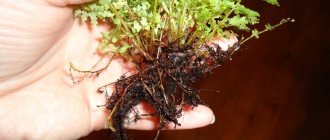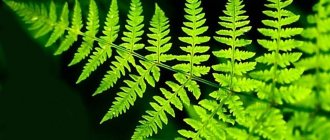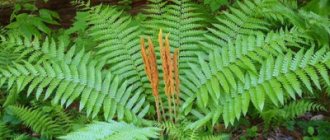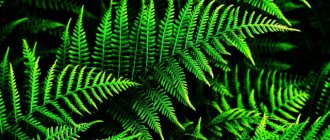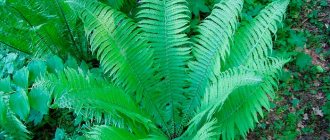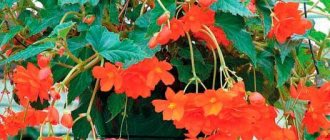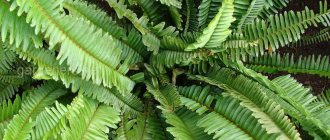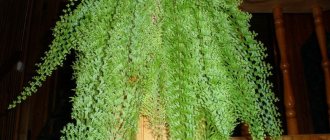Ferns are the most numerous division of higher spore-bearing vascular plants. These are the oldest inhabitants of our planet. No matter how much the climate on Earth has changed, among the huge number of plant species, only ferns have been able to adapt. They have survived to this day, growing in all climatic zones and striking in their diversity. People have long treated ferns in a special way, distinguishing them from other plants. Relict plants of the Mesozoic era, contemporaries of dinosaurs, living fossils - all this can be said about ferns.
Fern - a perennial herbaceous plant from the family of true ferns - has a strong, obliquely growing rhizome with an aboveground stem up to 1 m thick. The rhizome bears a bunch of pinnately dissected leaves. On their lower part there are clusters of sporangia (soruses). Ferns (Polypodiophyta) belong to the oldest groups of higher plants. Ferns belong to the Fern division; there are approximately 12 thousand species of them. In indoor floriculture, in accordance with the accepted systematization, ferns belong to the group of decorative leaf plants.
POTTED FENS
Many decorative species of ferns belong to different classes, orders, and families. Ferns are very widespread; in fact, they grow all over the globe and are found in a wide variety of places. But the greatest diversity of these plants is observed in tropical rainforests. The most commonly grown potted ferns are:
- Adiantum capillus veneris;
- Asplenium bulbiferum;
- Nephrolepis exaltata;
- Golden polypodium (Polypodium aureum);
- Platycerium alcicorr
Home green pets
Indoor plants allow a person to get closer to nature without even leaving the apartment. And indeed, in gray panel buildings, they are the only things that help lift the mood. At the same time, these pets require care, without which they can completely wither. By selecting different species, plant growers can have a blooming garden on their windowsill throughout almost the entire year.
Some varieties are grown for their edible fruits, such as orange, pomegranate, lemon, etc., while others are grown for their ornamental appearance. One of the most common is the indoor fern, photos of which can often be found in plant growing magazines.
Many mysterious tales and legends are associated with it. Perhaps this is one of the most ancient plants on our planet.
INTERESTING ABOUT FERNES
The fern itself, due to its physical, biological and chemical composition, is considered a genuine treasure. Fern shoots and rhizomes are used for medicinal purposes. Fern has been used for medicinal purposes since ancient times. The properties of the fern were described by Dioscorides, Pliny, Avicenna and others. According to its chemical and biological composition, the fern belongs to radioprotector plants, healers and elixirs. It contains 18 valuable amino acids: fructose, sucrose, glucose, arabinose, fiber, ash, protein and amine nitrogen, 40% starch, alkaloids, essential oils, tannins and orec-tannic acid.
Scientists have discovered a species of fern that grows well even in the presence of high concentrations of arsenic in the soil. They suggested that this plant, namely Pteris vittata, could be used to cleanse land and water from THIS TOXIC element or its compounds. Scientists have proposed passing water through reservoirs seeded with this type of fern to cleanse it of arsenic.
Most likely, everyone, without exception, is well aware of the story that once a year on Ivan Kupala, on the shortest night of the year, in a deep forest, under a birch tree with three trunks from one root, a fern blooms. Its flower glows like a flame. If you find this flower, you will have good luck in any matter. And the fern flower is protected by its evil spirits, which does not allow it to be taken out of the forest. Unfortunately, this, although beautiful, is just a legend. Ferns do not bloom , but reproduce by spores.
On the underside of the leaves of most ferns there are special structures called sori, which contain sporangia - organs that form spores. And in some types of ferns, spores are located on special modified leaves.
Signs
The magical properties of fern attract and alarm at the same time. There are many signs indicating both the positive impact of a flower on a person and its negative impact. Many people wonder whether it is beneficial or harmful, whether it has a bad or good effect, and where to keep the fern.
- With the advent of fern, character traits such as temper and aggressiveness . The condition of people and energy in the house is stabilizing.
- Relationships between people with opposite temperaments are balanced. A calm, harmonious atmosphere is established in the family.
- A growing flower attracts good luck in business and material well-being. Protects the owner from unreasonable expenses.
- The plant protects the house and its inhabitants from evil spirits , taking on all the negativity.
- It is believed that the flower is an energy vampire that absorbs human energy.
Physical discomfort from close proximity to a fern may be associated with an allergic reaction to the spores of the plant, and headaches may also occur.
TYPES OF FERNES AND PLACES OF GROWING
When we hear the word “fern,” most of us imagine a pot of unattractive grass. But few people know that ferns have populated all continents, except, of course, Antarctica, and they feel great in any conditions.
Tree-like giant ferns, liana ferns, and epiphytic ferns grow in tropical forests. Epiphytes are plants that grow on other plants, mainly on tree branches and trunks, as well as on leaves (epiphylls), and obtain the necessary nutrients from the environment, but not from the host plant. That is, in no case should one confuse epiphytic plants and parasitic plants. In the process of evolution, some epiphytes have developed special adaptations for capturing water and minerals from the air. These are, for example, spongy covers on the roots, or so-called root nests - plexuses of roots in the form of a basket in which dust and fallen leaves accumulate and thus create soil for feeding roots. A similar adaptation is found in the Asplenium fern . Other epiphytes, such as the Platicerium fern , have so-called niche leaves that form a niche on the trunk in which soil is also created.
Asplenium nidus
There are giant ferns, for example, Asplenium nidus. This plant is a typical epiphyte, native to tropical Asia. Ferns grow on the trunks of large trees. Reaching enormous sizes (diameter - several meters, and weight - up to a ton or more), asplenium breaks even gigantic trees with its weight. We know aspleniums as ordinary indoor plants, whose sizes are much more modest.
Among ferns there are species that live under water, for example, Marsilea quadrifolia . This fern is often used to decorate small ponds on the site, as the appearance is very decorative.
marsilea quadrifolia
Salviniaceae family is most famous here . These plants can be called weeds of tropical rivers. Reproducing in huge quantities, salvinia becomes an obstacle to water transport, interferes with the normal operation of hydroelectric power stations, and clogs fishing nets.
Salviniaceae
Azola caroliniana
Another floating fern is Azol a caroliniana , grown in rice fields. This plant has a unique ability to accumulate nitrogen, in addition, Azola suppresses the growth of weeds in rice plantations.
Among the ferns, there are dwarf ferns that are only a few millimeters long. These microscopic plants grow in tropical forests on the surface of stones or the ground, rising to a small height along tree trunks. Among the ferns there are real “trees” - the genus Cyathea , whose height reaches 25 meters, and the trunk diameter reaches half a meter.
Fern genus Cyathea
There are ferns whose leaf petioles can rival steel in strength - Dicranopteris . You can get through the thickets of Dicranopteris only by working hard with a machete, on the blade of which the fern leaves marks, as if cutting real metal wire.
Dicranopteris
Growing ferns indoors became fashionable in the 18th century. At that time, ferns could be seen in elite English salons; they were decorations of expensive hotels and houses of noble people. However, only a few species were grown as ordinary houseplants, because gas combustion products and smoke from coal, which was then used for heating, are extremely poisonous to almost all ferns. Then the British came up with special “fern showcases” (glass boxes framed with cast iron) for ferns, which maintained the necessary air and soil humidity.
Flower growers became interested in ferns at the beginning of the 19th century. In Europe, they planted gardens and parks and decorated picturesque shady corners near water bodies. Currently, ferns are highly valued by both professional and amateur gardeners all over the world. For example, in Germany there is a whole network of greenhouses that specialize exclusively in the cultivation and sale of ferns, the leaves of which are then used in making bouquets and various flower arrangements.
It is believed that more than two thousand species of ferns are now suitable for growing indoors. But despite this, resistant cultures of more than four hundred species of ferns have been bred in greenhouses and greenhouses of botanical gardens.
There is no consensus among professionals as to whether these plants are difficult or easy to grow. But one thing is for sure: ferns require constant care.
Will it never bloom?
No matter how beautiful the legend is, it is never destined to come true in real life. Because in fact, neither forest nor indoor ferns have ever bloomed and will never bloom. This is a family that, like mosses or horsetails, simply does not have flowers. Many will remember from a school course in botany that after a flower fades, fruits form in its place.
And the indoor fern has no seeds. They produce spores, which this plant uses to reproduce, and they must first touch water.
STRUCTURE OF FENS
Ferns (Polypodiophyta) are a division of higher plants occupying an intermediate position between rhinophytes and gymnosperms. Ferns differ from rhiniophytes mainly by the presence of roots and leaves, and from gymnosperms - by the absence of villages. Ferns originated from rhiniophytes, to which the oldest Devonian ferns were very close. Some of the most primitive genera were intermediate forms between rhyniophytes and typical ferns). Ferns, like other higher plants, are characterized by an alternation of generations - asexual (sporophyte) and sexual (gameophyte), with the dominance of the asexual generation.
Fern sporophyte is a herbaceous or tree-like plant, mostly with large, repeatedly dissected leaves (young leaves are usually snail-shaped). Ferns are characterized by a wide variety of shapes, internal structures and sizes. Their leaves vary from multiple pinnately dissected to whole, from gigantic - 5-6 m long (in some representatives of Marattia and Cyathea) and even up to 30 m (curly leaves in Lygodiu articulatum) to tiny leaves only 3-4 mm long, consisting of 1 layer cells (in Trichomanes goebelianu). The length of the stems of ferns varies from a few centimeters to 20-25 m (in some species of Cyathea). They are underground (rhizomes) and aboveground, erect and climbing, simple and branched. In most sporangia are located on ordinary green leaves; some leaves are differentiated into spore-bearing (sporophylls) and vegetative, green.
Most ferns are homosporous. Among modern ferns, only three small families of aquatic ferns are heterosporous: Marsileaaceae, Salviniaceae and Azollaceae.
Vaii
Ferns lack true leaves. Evolutionary transformations endowed them with prototypes of leaves, looking like a system of branches laid in one plane. Botanists call this phenomenon a flat branch, frond or pre-shoot. The appearance of the fern leaf is made up of complex dissected fronds, which are smooth or pubescent, thin or leathery, light or dark green.
The preshoots, which develop from snail-shaped primordia, are similar to the leaf blades of modern flowering plants. Lacey pinnately complex plane flies are planted on strong petioles - rachis, similar to twigs. The appearance of a fern leaf on the reverse side in mature individuals is a collection of brown dots, sporangia - containers for spores.
Watering
The soil environment in which the indoor fern develops should not be allowed to dry out.
Or, on the contrary, it was too waterlogged. With the onset of winter, watering must be significantly limited. Almost all types of this plant require high air humidity, so you need to either constantly spray them, or install a mini-fountain or container of water nearby. In addition, experts recommend giving ferns a warm shower once a week. In spring, the plant often requires replanting. After all, indoor ferns tend to grow greatly. When they become crowded, their roots cannot develop fully, which immediately affects the leaves.
Useful video
Watch a video about the varieties and care of indoor ferns:
Ferns are spreading evergreens that can enliven any interior if conditions are created that are comfortable for them. They love moisture and warmth, and in return for this they will please the eye all year round, without requiring constant care, with the exception of watering and moistening the leaves.
Find out more information about the types of ferns: adiantum, asplenium, blechnum, davallia, nephrolepis, pellea, platicerium, phlebodium, cirtomium.
Nephrolepis
This is the most common variety of indoor ferns and belongs to the Devalliaceae family. It can often be found not only in apartments, but also in the offices of many companies. Some researchers believe that the homeland of the indoor fern Nephrolepis is Southeast Asia.
This species is considered one of the most popular and most unpretentious: caring for it is not difficult. To successfully grow the Nephrolepis fern, you do not need a lot of light: this plant is quite shade-tolerant, it can grow well under artificial light.
The only obstacle to its normal development is the dry air of apartments. Therefore, the green pet needs to be provided with high humidity, spraying more often, and especially in winter. The plant needs moderate watering after the soil dries out slightly. At the same time, a long-term lack of moisture in the earthen coma causes the leaves to die.
General description of fern-like plants
There are several versions about what a fern is. The scientific community ranks it among the oldest plants - rhinophytes. In the process of evolution, the structure of the fern has become more complex, which is why the fern is classified as a higher plant.
Fern cannot be confused with any other plant
Several facts that support this opinion:
- The plant develops in cycles.
- There is a developed vascular system.
- The bushes are distinguished by their good ability to adapt to the way they live on land.
Representatives of ferns are perennial shrubs belonging to the spore family. However, many gardeners are still concerned about the question: is a fern a shrub or a herb? Both answers are positive.
Interesting! There are plants so tall that they are considered trees.
Ferns come in a variety of colors and colors. Therefore, each plant is beautiful in its own way and certainly decorates the place where it grows. These unusual shrubs are often used in landscape design and home interiors. They practically do not get sick with proper care.
The plant has the appearance of an evergreen shrub and does not bloom. However, for the Slavs this flower was and remains a symbol of love and happiness. There is a tradition to look for it on the night of Ivan Kupala.
Biological classification of ferns
The classification of ferns is quite complex due to the large number of species. Scientists have long attempted to build a system. There were trial designs that differed from each other. And only much later did a unified classification emerge, based on the structure of the reproductive organ (sporangium) and some other characteristics.
Briefly, all plants are divided into 2 groups: ancient and modern. The department of ferns consists of 7 classes of extinct and currently existing vascular plants. These classes are briefly presented below:
- the oldest and simplest group in structure is Aneurophytopsida;
- an ancient representative similar in appearance to conifers - Archaeopteridopsida;
- “blind evolutionary branch” - this is the nickname of Cladoxylopsida;
- the transitional category to contemporaries is represented by Zygopteridopsida or Goenopteridopsida;
- modern plants - Ophioglossopsida or grasshoppers (Ophioglossopsida);
- large and compact perennials - Marattiopsida;
- yet another contemporaries, among which perennials are more common and annuals are less common - Polypodiopsida.
The latter are divided into 3 subclasses: Polypodiidae, Marsileidae, Salviniidae.
Transitional class of ferns
Properties of culture
The chemical composition of the plant is rich in microelements. Most often, parts of the plant are used in cosmetic procedures, medicine and cooking. Being in fact a low-calorie product, fern is valued for the high absorption of its constituent proteins.
Red clover: description of the plant, properties and applications
Among eastern peoples, fern is included in the diet. The most useful are young shoots, rich in vitamins A, B, E and PP.
Important! It is forbidden to consume unprocessed parts of the fern. Fresh parts of the plant can cause poisoning with general intoxication of the body and vomiting.
The use of young bracken shoots is popular. As the plant grows, it becomes poisonous and unfit for consumption. Its beneficial qualities are manifested in strengthening the immune system, maintaining the functioning of the cardiovascular system, optimizing blood glucose levels, and stimulating metabolic processes. In addition, toxins and waste are removed from the body.
Bracken is valued in cosmetic procedures for inhibiting the aging process and maintaining a fresh appearance. Eating bracken salad is beneficial. After boiling the fresh plant, you need to marinate and stew the product. By adding onions fried with meat, you can serve chilled.
Orlyak
There are a number of contraindications for the use of fern: pregnancy and the presence of diseases of internal organs. Before using such a product, you must consult a specialist.
Edible varieties
Among fern-like plants there are both poisonous and edible species. The former are characterized by dark green foliage, while the latter have light green fronds.
The most common edible varieties include:
- Common bracken (Pteridum Aquilinum) with large, rigid, trifoliate leaf blades, shaped like an eagle’s wing, collected in a spreading rosette up to 1.5 m high;
- Osmunda cinnamon (Osmunda Cinnamomea) with a short dense rhizome and large feathery shiny fronds emerging from it, the length of which under favorable conditions can reach up to 2 m;
- Common ostrich (Matteuccia Struthiopteris) with a strictly shaped funnel-shaped rosette and cone-shaped leaf plates up to 1.5 m high.
To remove bitterness, freshly picked fern shoots are boiled in salted water for 5-10 minutes, then drained in a colander and washed with cold water, after which they are fried, stewed, pickled and salted. The plant is added to first and second courses, omelettes, casseroles and even hot sandwiches are prepared with it.
Peeled rhizomes are consumed baked, and cleansing and medicinal teas are brewed with them.
Maidenhair
This fern is a houseplant, a photo of which proves its incredible beauty. It's quite common. Its leaves do not absorb moisture at all, so drops of water flow beautifully down them. Adiantums are represented by powerful but low bushes. This species does not tolerate direct sunlight. It has creeping stems, erect dictyostelic rhizomes, covered with narrow brown scales.
This species is associated with the most amazing name of indoor ferns - Venus hair. Indeed, this incredibly beautiful plant with a light green leaf blade up to forty centimeters long, segments fifteen millimeters wide, has a wedge-shaped base and a fan-shaped top. Venus hair is a frequent visitor to city apartments and country houses.
Thanks to the amazing shape and beauty of the leaves, these indoor ferns are often used in compositions in winter gardens, where they form colorful design solutions.
Value in the apartment
The main function in the house is decoration and landscaping. It filters the air well due to the large surface of green leaves and traps dust.
There is also an esoteric meaning: the fern is believed to bring good luck and attract wealth, which is why superstitious people love to grow it.
Read more information about signs and superstitions, as well as where it is best to keep ferns in an apartment here.
